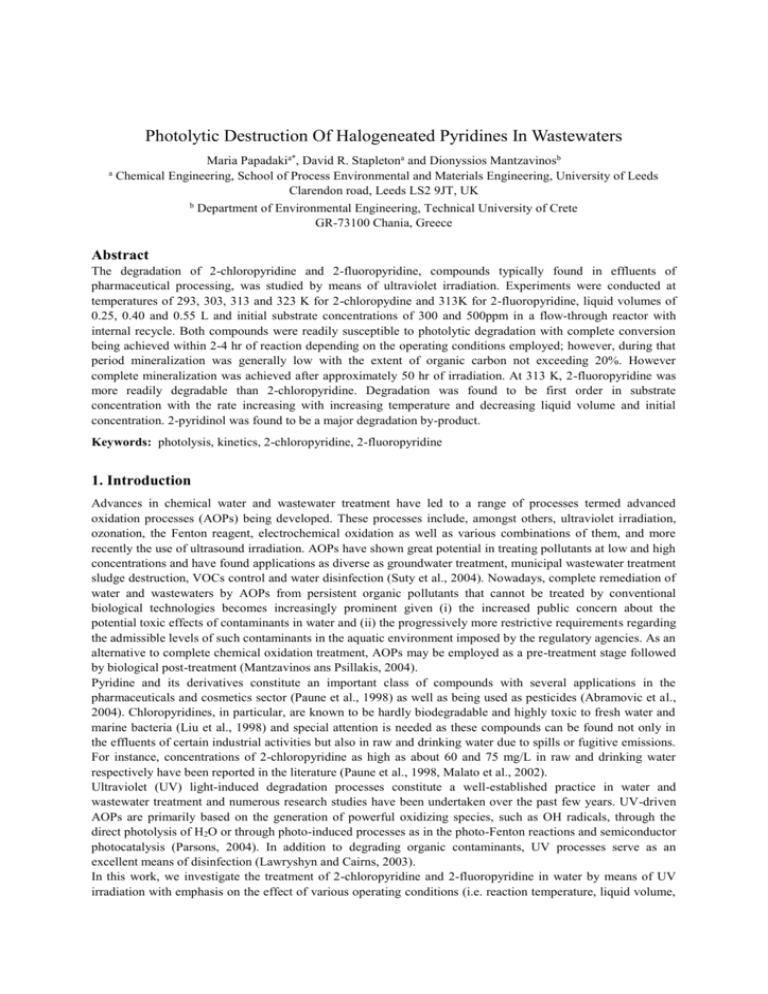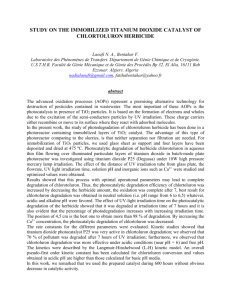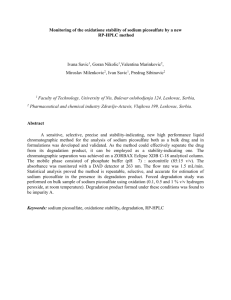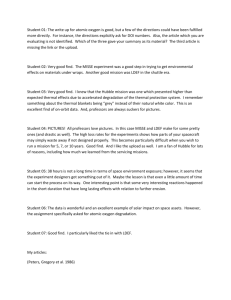216 photolytic destruction of halogeneated pyridines in wastewaters
advertisement

Photolytic Destruction Of Halogeneated Pyridines In Wastewaters a Maria Papadakia*, David R. Stapletona and Dionyssios Mantzavinosb Chemical Engineering, School of Process Environmental and Materials Engineering, University of Leeds Clarendon road, Leeds LS2 9JT, UK b Department of Environmental Engineering, Technical University of Crete GR-73100 Chania, Greece Abstract The degradation of 2-chloropyridine and 2-fluoropyridine, compounds typically found in effluents of pharmaceutical processing, was studied by means of ultraviolet irradiation. Experiments were conducted at temperatures of 293, 303, 313 and 323 K for 2-chloropydine and 313K for 2-fluoropyridine, liquid volumes of 0.25, 0.40 and 0.55 L and initial substrate concentrations of 300 and 500ppm in a flow-through reactor with internal recycle. Both compounds were readily susceptible to photolytic degradation with complete conversion being achieved within 2-4 hr of reaction depending on the operating conditions employed; however, during that period mineralization was generally low with the extent of organic carbon not exceeding 20%. However complete mineralization was achieved after approximately 50 hr of irradiation. At 313 K, 2-fluoropyridine was more readily degradable than 2-chloropyridine. Degradation was found to be first order in substrate concentration with the rate increasing with increasing temperature and decreasing liquid volume and initial concentration. 2-pyridinol was found to be a major degradation by-product. Keywords: photolysis, kinetics, 2-chloropyridine, 2-fluoropyridine 1. Introduction Advances in chemical water and wastewater treatment have led to a range of processes termed advanced oxidation processes (AOPs) being developed. These processes include, amongst others, ultraviolet irradiation, ozonation, the Fenton reagent, electrochemical oxidation as well as various combinations of them, and more recently the use of ultrasound irradiation. AOPs have shown great potential in treating pollutants at low and high concentrations and have found applications as diverse as groundwater treatment, municipal wastewater treatment sludge destruction, VOCs control and water disinfection (Suty et al., 2004). Nowadays, complete remediation of water and wastewaters by AOPs from persistent organic pollutants that cannot be treated by conventional biological technologies becomes increasingly prominent given (i) the increased public concern about the potential toxic effects of contaminants in water and (ii) the progressively more restrictive requirements regarding the admissible levels of such contaminants in the aquatic environment imposed by the regulatory agencies. As an alternative to complete chemical oxidation treatment, AOPs may be employed as a pre-treatment stage followed by biological post-treatment (Mantzavinos ans Psillakis, 2004). Pyridine and its derivatives constitute an important class of compounds with several applications in the pharmaceuticals and cosmetics sector (Paune et al., 1998) as well as being used as pesticides (Abramovic et al., 2004). Chloropyridines, in particular, are known to be hardly biodegradable and highly toxic to fresh water and marine bacteria (Liu et al., 1998) and special attention is needed as these compounds can be found not only in the effluents of certain industrial activities but also in raw and drinking water due to spills or fugitive emissions. For instance, concentrations of 2-chloropyridine as high as about 60 and 75 mg/L in raw and drinking water respectively have been reported in the literature (Paune et al., 1998, Malato et al., 2002). Ultraviolet (UV) light-induced degradation processes constitute a well-established practice in water and wastewater treatment and numerous research studies have been undertaken over the past few years. UV-driven AOPs are primarily based on the generation of powerful oxidizing species, such as OH radicals, through the direct photolysis of H2O or through photo-induced processes as in the photo-Fenton reactions and semiconductor photocatalysis (Parsons, 2004). In addition to degrading organic contaminants, UV processes serve as an excellent means of disinfection (Lawryshyn and Cairns, 2003). In this work, we investigate the treatment of 2-chloropyridine and 2-fluoropyridine in water by means of UV irradiation with emphasis on the effect of various operating conditions (i.e. reaction temperature, liquid volume, initial substrate concentration) on degradation rates. In our previous work (Stapleton et al, in press) we reported on a comparative study of the degradation of pyridines using different AOPs; photolysis and photo-Fenton oxidation were found to be the most effective methods for pyridine degradation. 2. Materials and Methods 2.1 Materials 2-Chloropyridine (2CP), 2-fluoropyridine (2FP) (all 98% purity) were supplied by Fluka and used without further purification. 2.2 Experimental setup Figure 1 shows the arrangement employed for the photodegradation experiments. It consists of a tubular reactor, (R), inside which an Upland Pen Ray UV lamp (254 nm, 110 W) with a diameter of approximately 10 mm and a length of 200mm was submerged. The reactor diameter was 30 mm. A cooling system facility was also available, thus maintaining a constant liquid temperature. A schematic of the arrangement employed is shown in Figure 1. R P 10mm 300mm UV lamp V es se l Temperature bath 30mm Figure 1. Equipment schematic A vessel (V) of an appropriate volume was submerged into the constant temperature bath. A pump (P) capable of circulating 200 ml/min was used to ensure isothermal operation via continuous recirculation of the solution. It should be noted that substrate degradation other than in the illuminated area, ie inside the tubular reactor was found to be negligible. 2.3. Analytical Samples periodically drawn from the reactor were analyzed by means of HPLC (Hitachi/Merk LaChrom L7400 UV detector, L-7100 pump) to follow the concentration profiles of the substrate. Separation was carried out on a Symmetry Shield RP8 column (Waters) using 20:80 acetonitrile:water as an isocratic mobile phase at 1 ml/min or gradient elution from 20:80 to 0:100 acetonitrile:water at 1 ml/min. UV detection was set at 265 nm. The total organic carbon (TOC) content of the liquid phase was measured using a Shimadzu 5050A analyzer equipped with an automatic sampler. A Corning – pH/ion meter 135 was used to measure the pH of the liquid phase. All runs were carried out at the solution ambient pH, with an initial value of about 8 for 2CP for instance. Solution pH was left uncontrolled during the experiments although it was periodically monitored. 3. Results and Discussion Experiments were conducted at 293, 303, 314 and 323 K at initial substrate concentrations of 300 and 500ppm in aqueous solutions of 0.25, 0.40 and 0.55 L. Complete degradation of both substances was achieved within a few hours of irradiation, depending on the experimental conditions employed. Moreover, the decomposition of the original substrate was accompanied by the release of inorganic Cl - and F-, which was manifested by the rapid drop in the solution pH, as reported elsewhere (Stapleton et al, in press). 2-Pyridinol has been identified as one of the major intermediates formed during the degradation of both substances. TOC removal was very small during this period, but continuing irradiation over a period of two to three days resulted in complete mineralisation. Figures 2 and 3 show concentration-time profiles during the photodegradation of 2CPy (2chloropyridine) as a function of liquid volume and reaction temperature at initial concentrations of 300 and 500ppm respectively. 1 0.9 0.8 0.7 313K_300PPM_0.25L 303K_300PPM_0.25L 313K_300PPM_0.4L 313K_300PPM_0.55L 293K_300PPM_0.25L 303K_300PPM_0.4L 293K_300PPM_0.4L 303K_300PPM_0.55L C/C0 0.6 0.5 0.4 0.3 0.2 0.1 0 0 20 40 60 80 100 120 140 160 180 200 Time (min) Figure 2. Normalised concentration reduction during the photolytic degradation of 2-chloropyridine in aqueous solution with an initial concentration of 300ppm. As can be seen, photolysis proceeds faster at higher temperatures and smaller liquid volumes. It can be seen that measurements performed at the same temperature and initial concentration reach almost complete degradation in approximately proportional lengths of time. So, at 313K and 300 ppm an 80% conversion is achieved in 20 min in a volume of 0.25L, 40 min in a volume of 0.4 L and 60 min in a volume of 0.55L. Accordingly, a 70% conversion is achieved in 20, 40 and 60 min if a 500ppm solution of volumes 0.25, 0.4 and 0.55L, respectively, is irradiated at 313 K. Measurements on solutions of different initial concentrations but of the same volume and temperature also display a similar behaviour as can be seen by a comparison of figures 2 and 3. For instance, for measurements on 0.4 L solution volume at 313K, a 70% conversion is achieved in 50 and 28min for samples of initial concentration of 500 and 300 ppm respectively. Similarly, for samples of 500ppm and 300ppm of a 0.55L volume treated under the same temperatures the process time for a 70% conversion is 60 and 40 min, respectively. It is worth noticing, however, that at very low volumes (0.25L) and high temperatures (40 oC) the substrate degradation is very fast and there is very little difference in the time needed to achieve complete decomposition between the two selected initial concentrations. 1 0.9 313K_500PPM_0.25L 323K_500PPM_0.4L 0.8 313K_500ppm_0.4L 313K_500PPM_0.55L 293K_500PPM_0.25L 293K_500PPM_0.4L 0.7 C/C0 0.6 0.5 0.4 0.3 0.2 0.1 0 0 50 100 150 200 250 Time (min) Figure 3. Normalised concentration reduction during the photolytic degradation of 2-chloropyridine in aqueous solution with an initial concentration of 500ppm. Figure 4 shows a comparison between the photolytic decomposition of 2-chloropyridine and 2-fluoropyridine at different conditions. As can be seen the rate of decomposition of 2-FPy(2-fluoropyridine) at 313 is higher than that of 2CPy in all volumes and/or initial concentrations employed. The electronegativity of fluorine is greater than that of chlorine, which should result in stronger bonding. In fact C-F bond energy is reported as 488 kJ/mol and the C-Cl bond is 330 kJ/mol. The F-C bond should therefore be less susceptible to radical attack. The UV absorbance at 254nm of 2-FPy is weaker than that of 2-CPy, (3.43 and 3.63 respectively, units in logarithm epsilon of absorbance) indicating that 2-CPy should be more susceptible to absorption and therefore decomposition. However there are more major intermediates formed in the decomposition of 2-FPy indicating a more complex reaction mechanism. The role played by inorganic fluorine in solution is not known, the behaviour of this may explain the different photoproducts and reaction rates. 1 FPY_313K_300PPM_0.25L FPY_313K_500_0.25L FPY_313K_300PPM_0.4L CPY_313K_300PPM_0.25L FPY_313K_500PPM_0.4L CPY_313K_500PPM_0.25L CPY_313K_300PPM_0.4L CPY_313K_500ppm_0.4L CPY_313K_500PPM_0.55L 0.9 0.8 0.7 C/C0 0.6 0.5 0.4 0.3 0.2 0.1 0 0 10 20 30 40 50 60 70 80 90 100 Time (min) Figure 4. Comparison of normalised concentration reduction during the photolytic degradation of 2chloropyridine and 2-fluoropyridine in aqueous solution at different conditions. Although it is believed and it is currently under investigation that the reaction follows a more complex mechanism, especially during the initial stages of UV irradiation, the data can be fitted adequately well to a pseudo-first order rate. In figure 5 there are typical results of the linear fit of –ln(C/C0) versus time for a number of measurements at different conditions. 3.5 3 CPY_313K_300PPM_0.25L CPY_313K_500ppm_0.4L CPY_293K_500PPM_0.4L CPY_313K_500PPM_0.25L CPY_303K_300PPM_0.25L CPY_303K_500PPM_0.25L CPY_293K_300PPM_0.55L FPY_313K_500_0.25L FPY_313k_500PPM_0.4L - ln (C/C0) 2.5 2 1.5 1 0.5 0 0 20 40 60 80 100 120 140 160 180 200 Time (min) Figure 5. Pseudo-first order kinetics of 2-chloropyridine degradation at different conditions. The rate constants for all measurements of 2CP were plotted in an Arrhenius type graph shown in Figure 6. It can be seen that different volumes and initial concentrations form nearly parallel straight lines, which implies that the the activation energy is approximately the same. The shift of the lines (different frequency factors) as the initial concentration or the solution volume changes indicates that the reaction follows a different type kinetics as suggested by Jirkovsky et al 2004. This is currently being investigated. 0.00305 -2 -2.5 0.0031 0.00315 0.0032 0.00325 0.0033 ln(k) 0.0034 y1 = -5563.7x + 12.034 5 y2 = -6004.3x + 16.355 1 -4 2 1: 300ppm_0.25L -4.5 -5 -6 y4 = -7105.6x + 18.93 3 y5 = -6651.4x + 17.351 2: 500ppm_0.25L 3: 300ppm_0.4L 4: 300ppm_0.55L -5.5 0.00345 y3 = -5374.7x + 13.845 -3 -3.5 0.00335 y6 = -7394.9x + 19.324 4 5: 500ppm_0.4L 6: 500ppm_0.55L 6 1/T (K-1) Figure 6. Arrhenius dependency of pseudo-first order rate coefficient k on absolute temperature of 2chloropyridine degradation at different conditions. 4. Conclusions The photolytic degradation of 2-chloropyridine and 2-fluoropyridine has been studied at different temperatures, volumes and initial concentrations with 2-chloropyridine being more stable than fluoropyridine at the conditions under consideration. Their rate of photolytic decomposition follows a pheudo-first order kinetics. The decomposition is faster at lower initial concentrations and solution volumes. 2-pyridinol is one of the major intermediates formed during the photolysis of either substance. Complete TOC removal is achieved at prolonged irradiation times. 5. References Abramovic, B.F., Anderluh, V.B., Topalov, A.S., Gaal, F.F., 2004, Titanium dioxide mediated photocatalytic degradation of 3-amino-2-chloropyridine, Applied Catalysis B – Environmental, 48, 213-221. Jirkovsky, J. Krysa, J, Waldner, G. and Grabner, G., 2004, Kinetic models of photocatalytic degradation of oxalic acid involving independent or competitive adsorption of oxygen, SPEA 3, 30 June-2-July, Barcelona, Spain. Lawryshyn, Y.A., Cairns, B., 2003, UV disinfection of water: the need for UV reactor validation, Water Science & Technology – Water Supply, 3, 293-300. Liu, S.M., Wu, C.H., Huang, H.J., 1998, Toxicity and anaerobic biodegradation of pyridine and its derivatives under sulfidogenic conditions, Chemosphere, 36, 2345-2357. Malato, S., Blanco, J., Caceres, J., Fernandez-Alba, A. R., Aguera, A. and Rodriguez, A. ,2002, Photocatalytic treatment of water-soluble pesticides by photo-Fenton and TiO2 using solar energy. Catalysis Today, 76, 209220. Mantzavinos, D., Psillakis, E., 2004, Enhancement of biodegradability of industrial wastewaters by chemical oxidation pre-treatment, Journal of Chemical Technology & Biotechnology, 79, 431-454. Parsons, S., 2004, Advanced Oxidation Processes for Water and Wastewater Treatment, First edition, IWA Publishing, London, pp.7. Paune, F., Caixach, J., Espadaler, I., Om, J., Rivera, J., 1998, Assessment of the removal of organic chemicals from raw and drinking water at a Llobregat river water works plant using GAC, Water Research, 32, 3313-3324. Stapleton, D.R., Emery, R.J., Smith, C., Pochet, C., Fernandez-Dominguez, A., Mantzavinos, D. and Papadaki, M., (in press), Degradation of 2-chloropyridine in water by ultraviolet and ultrasound irradiation, International Journal of environmental pollution. Suty, H., De Traversay, C., Cost, M., 2004, Applications of advanced oxidation processes: present and future, Water Science & Technology, 49, 227-233. Acknowledgments The financial support of this work from the Engineering and Physical Sciences Research Council, UK is greatly acknowledged.







